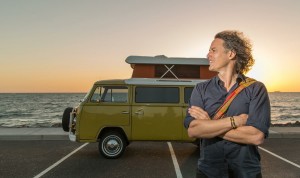COMM2625 MEDIA 2 – Field Production 11th of September 2015
Daniel Bowden
s3521907
SITE LINK: http://s3521907.wix.com/audioorganica#!yidaki-by-the-yarra/vdi3u
‘Yidaki’ is the traditional name for the didgeridoo, it has a unique sound quality that becomes amplified when played in the ‘sweet-spot’ under the arch of the Morell Bridge.
Kent Morris, who is playing the yidaki in this production, is a Songwriter, Producer, Musician and CEO of The Torch in Victoria.
Kent is also a proud descendent of the Barkindji people of the Darling River in New South Wales and here in this piece, we are able to understand the Morell space, not only in an aural context but in a cultural and spiritual one too.
Yidaki by the Yarra with Kent Morris
This work consists of recordings made on a short trip to the Morell Bridge in South Yarra with Songwriter, Producer and The Torch CEO, Kent Morris. It features Kent’s yidaki (didgeridoo) playing performed and recorded at the location by the river.
The piece is introduced with a brief phone conversation inviting Kent to be apart of the project and eventually, an informal interview inside Kent’s kombi that uncovers the challenges of Kent’s work as a producer. This in-car conversation is included in order to provide the listener with Kent’s background which I’m hoping will enrich the experience of listening to his playing.
In the background can be heard a CD of Geoffrey Gurrumul Yunupingu’s album Rrakala. This reinforces Kent’s own indigenous heritage and the fact that the location, Birrarung, is important to Aboriginal people, hence my decision to record a traditional instrument such as the yidaki there.
Another important reason for recording the yidaki in this space, is that its sound quality highlights the echoes and the organic delay effect caused by the bridge’s parabolic underside of smooth curved bricks. The clap sticks served to further elaborate the effect of the bridge on the sound quality as well as heightening the piece’s cultural context.
The recording equipment that I used included an H6 Zoom recorder with a 120 degree axis X/Y mic plus two phantom powered Rode studio condenser upright microphones. To achieve the maximum left/right pan width, I had to separate the two condenser mics approximately 4 metres apart, and positioned to the edges of the balustrade above. The Zoom mic and recorder remained central to the span of the bridge, between the condenser mics and at speaking height to produce a symmetrical
sound split. The sounds that were closer to the space, like the yidaki and the voice, were primarily picked up by the Zoom and anything beyond the space, like the traffic and the pedestrians, were picked up by the condenser mics. Much of the session was spent readjusting the microphones’ positions, so that I could achieve the best possible example of the sound space.
The time of the recording session took place after 10pm due to Kent’s daytime commitments and it was serendipitous that we were confined to recording late because the freeway was quieter and so too was the normally busy bike path that runs through the space.
My interest in natural acoustics came from Trevor Cox’s article Past Echoes (2010) that was cited on Radio National’s Radiotonic edition entitled Volume Without Sparks by Timothy Nicastri (2015). Had I had more time, I may have produced further acoustic experiments where I explore how different curved surfaces affect the sound of different instruments. Having sadly not achieved all that I wanted to due to time restraints, I have again been made aware of the time management that must go into all Radio’s New Wave projects.
 Photo by Andrew Englisch (2014).
Photo by Andrew Englisch (2014).
_____
References;
- Cox, T, (21 August, 2010), Pg. 44, Past Echoes: New Scientist, London UK , Reed Elsevier.
- Gurrumul Yunupingu, G, (2011), [CD], Rrakala, NT Australia, Skinnyfish Music.
- Nicastri, T, (17th of April, 2015), Volume Without Sparks – Radiotonic, Radio National, Australia.